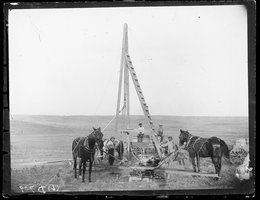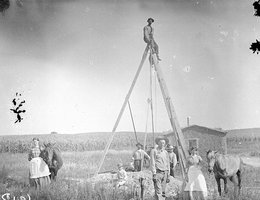

Each geographic area presented its own challenges and the settlers learned to adapt to the environment. Water was one of the first considerations in selecting a homestead, especially in Nebraska.
Early settlers first established claims near streams and rivers to take advantage of surface water. But these homesteads were quickly claimed, and so later settlers would have to go to new depths to find water.
That meant digging a well. Often a new settler would dig a test well on a potential claim. If water was found at a reasonable depth, the settler would stake a claim. If not, he or she would look at other properties. Not every site had underground water, so there were a lot of wells dug. Even after the well was dug, water had to be hauled up one bucket at a time in the early years.
Later, new technology would make using water much easier — windmills harnessed the wind to pump water to the surface.

In some parts of Nebraska, early settlers found the prairie covered with grass and little surface water. Land with easy access to creeks and streams was quickly snapped up by early settlers. Where water wasn’t readily available, a well had to be dug. The great underground river known as the Ogallala aquifer offered a generous supply of water beneath the surface in many areas. In some places, they guessed they could find good water close to the surface, so they took a shovel, dug until they found water and lined the hole to keep the walls from collapsing. It was back-breaking work.
Where water was farther down, especially in the western part of Nebraska, wells had to be dug tens or hundreds of feet deep. Augers, like those used to bore fence posts, could be used to reach up to 50 feet or so. In this photograph, the two men under the derrick seem to be using an auger. Exactly what Mr. Moyer was doing on top of the derrick we can only guess.

For still deeper wells, mechanical drilling machines had to be used often powered by horses. In these machines, a heavy drill bit was threaded onto a series of pipe sections. The horses were harnessed to a power take-off machine, and they would raise the bit up. Then the operator would drop it - pounding into the ground and breaking up any rocks it hit into small pieces. When they hit the water table, the hole was lined with iron casing to keep it from caving in.
Even after the well was dug, the work was not over. You still had to get the water to the surface where you could use it - to drink from, to cook and clean, and to water livestock. Wells not only supplied water, but they also were used to cool milk, butter, and meat.
"Well you wanted to know how we got water out of our wells here. We draw it with a windlass fixed just to one side of the well for the rope to wind on. And it passes over a wheel suspended immediately over the well. One end of the rope is attached to a galvanized Iron bucket with a hole through the bottom and a clapper fixed over the hole made just like that on a pump suck. And when you get a bucket of water to the top of the well you set it on a peg in a little trough, and the peg raises the suck. And if you set your bucket under the end of the trough you will get the water and if you don’t you won’t catch it, that’s all."
Drawing water up one bucket at a time was hard work and could never supply enough water for thirsty livestock. What the settlers needed was a machine that would capture a plentiful source of energy — like the wind — to pump the water to the surface. They needed a windmill to power a pump and fill their water tanks.

Windmills helped solve the problem of getting water to the surface by powering pumps. The first commercially successful American windmill was invented in 1854 by a New England mechanic named Daniel Halladay. To take advantage of the growing western market, he moved his company to Illinois. By the 1860s, other companies like the Eclipse had entered the fray, and windmills were in common use in Nebraska by the 1870s. The incessant winds on the plains turned the mill blades and that motion and energy was transferred to a pump at the bottom of the windmill tower. The pump then moved up and down to draw water from the well into storage tanks on the surface. Often the windmills dwarfed the houses.
Windmills evolved as inventive Nebraska and regional manufacturers varied designs to harness the wind more efficiently. A well with a windmill attached, could supply water to man and beast in whatever quantity was needed. There were many different types of windmills. They had names like: The Dandy, Everlasting, Favorite, Boss Vaneless, Aermotor, Fouk’s Accelerating Air Motor, Parson’s Colorado Wind Engine, The Iron Screw, and Aquarius the Water Bearer.